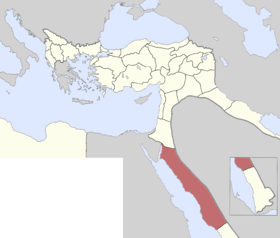Hejaz Vilayet
| Vilayet of the Hejaz Hijaz Vilayeti ولاية الحجاز ولايت حجاز |
|||||
| Vilayet of Ottoman Empire | |||||
|
|||||
|
Flag |
|||||
| Hejaz Vilayet in 1900 | |||||
| Capital | Mecca;Taif (summer residence) | ||||
| History | |||||
| • | Established | 1872 | |||
| • | Disestablished | 1916 | |||
| Population | |||||
| • | 1914 | 300,000 | |||
| Today part of |
|
||||
Flag
The Vilayet of the Hejaz (Arabic:ولاية الحجاز) (Ottoman:ولايت حجاز)refers to the Hejaz region of Arabia when it was administered as a first-level province (vilayet) of the Ottoman Empire. At the beginning of the 20th century it reportedly had an area of 96,500 square miles (250,000 km2). The Hejaz included all the area from the border of the Vilayet of Syria, south of Ma‛an, to the northern border with the Vilayet of Yemen, south of Al Lith.
Despite its lack of natural resources, the region had great political importance as the cradle of Islam and was a source of legitimacy for the Ottomans' rule. Subsidies provided by the state and zakat were the main source of income for the population of the two holy cities, but trade generated by the hajj was also an important source of revenue.
The Ottoman regular force in Hejaz was constituted as a fırka (division), attached to the Seventh Army in Yemen. Outside of cities and towns, Ottoman authority was weak. Only those two towns had permanent garrisons.
Sultan Selim I defeated the Mamluk Sultanate in 1517 and took over Egypt. The Hejaz was at the time, a Mamluk suzerainty and had relied on Egypt for grain imports, it was also under threat from an aggressive Portuguese navy in the Red Sea. As a result, the emir of Mecca at the time, Berekat ibn Muhammed Haseni, sent his 12-year-old son, Muhammad (future "Ebu-Numey"), to Egypt and pledged their allegiance to the Ottoman Sultan, along with the key to Mecca. The Sultan allowed the emir of Mecca to remain in power in exchange for loyalty to the Sultan. To strengthen the Sultan's legitimacy in Hejaz and in the Muslim world, the Sultan adopted the title Custodian of the Two Holy Mosques. Initially, the Ottomans administered the Hejaz under the Eyalet of Egypt. The Sharif of Mecca represented imperial authority in the region. Administration later fell to the Governors of Jeddah, and the Eyalet of Jeddah was later transformed into the Hejaz Vilayet, with a governor in Mecca.
...
Wikipedia


